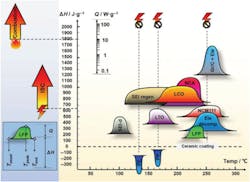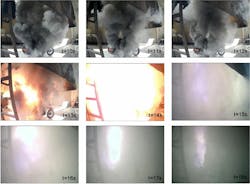Spontaneous Lithium Fires are Becoming Epidemic
What you'll learn:
- What causes common lithium fires?
- How some people deal with it.
- What can be done to prevent these fires.
Lithium-based batteries seem to be in everything we own. From tiny wireless earbuds to cars to entire home battery backups, they’re omnipresent. Big business, big industry, everything relies on them. Unfortunately, spontaneous lithium fires come along with that dependency. Lithium fires can ignite without warning and burn with intense heat, putting people, property, and the environment in harm's way. And it’s happening more than you may realize.
In fact, incidents involving lithium-ion batteries have become shockingly common worldwide. According to the United States government data, over 240 fires were reported across 64 waste and recycling facilities over seven years (2013-2020), all of which were caused by lithium batteries. These fires disrupted operations in 28 states across all EPA regions, creating economic and environmental challenges.
Consumers have also witnessed a surge in lithium-related fires involving personal devices and micromobility products, such as e-bikes, e-scooters, and smartphones. Between 2017 and 2022, over 25,000 overheating or fire-related incidents were reported.
According to an NFPA summary of FDNY data, New York City has seen an uptick in these fires since 2022, experiencing over 800 caused by lithium-ion batteries. Those fires claimed 30 lives and injured 400+ people, a stark reminder of the fire's devastating effects.
According to QBE’s analysis of UK fire-service data, the United Kingdom had a 93% increase in lithium-ion fires from 2022 to 2024, and e-bikes and scooters accounted for nearly a third of those incidents. Meanwhile, Western Australia firefighters attended three lithium battery fires per week in 2025, nearly double the number recorded in previous years.
Out-of-Control Fires Due to Thermal Runaway
Lithium-ion batteries usually ignite fires due to thermal runaway — a self-sustaining chain reaction in which the battery overheats uncontrollably, burning at 1,100°F (Fig. 1). During this process, the battery's internal chemicals break down rapidly. They emit flammable and toxic gases like carbon monoxide and hydrogen fluoride in addition to oxygen that can escalate into intense fires or explosions.
A single lithium-ion cell relies on chemical reactions between the anode, cathode, and electrolyte to store energy. Disturbing that balance through overheating, physical damage, overcharging, or short circuits causes internal heat buildup. Temperatures that rise above the critical threshold may melt the separator (the part that keeps the anode and cathode apart), leading to a short circuit.
This short circuit is problematic as it emits heat that moves to nearby cells. Battery packs, similar to those used in electric vehicles or energy storage systems, experience a chain reaction in which a failing cell can harm or destroy the next one. Oftentimes, these fires can’t be contained or stopped.
Firefighters may submerge lithium-ion batteries in water, slowing thermal runaway and preventing ignition spread. However, we can't extinguish metallic lithium battery fires with water, as that would make the reaction much worse. If that happens, lithium reacts, forming hydrogen gas, leading to more explosions or reignition after containing the fire. To combat this, firefighters use special dry chemical agents or submerge the device in sand or salt solutions to eliminate oxygen exposure.
What makes thermal runaway dangerous is that the fire can continue and worsen without an external ignition source. This makes lithium fires unpredictable as they often erupt without warning and burn intensely, especially underwater or after flames appear extinguished.
Other Fire Triggers
Besides thermal runaway, other factors may trigger or worsen fires. Overcharging or faulty chargers may cause cells to receive too much current, making them overheat. Physical damage from crushing, puncturing, or dropping a battery can lead to short circuits because the electrodes may deform. Internal short circuits may occur months or years later, as the battery may be exposed to tiny metal particles during production. If discarded batteries are crushed, exposed to moisture, or mixed with other materials, they may short-circuit and burst into flames.
I personally found a box of hundreds of 18650 lithium battery cells in my electronic supplies. I forgot that I was tinkering with them for a project years ago. I promptly got them out of my place and took them to a recycling center. However, the problem doesn’t end there.
“Hot Spot” Areas for Battery Fires
Recycling facilities are a common place for fires to erupt as batteries get crushed, punctured, or exposed to moisture. According to a National Waste & Recycling Association (NWRA) 2024 report, over 5,000 fires occur at recycling facilities. If a battery cell is damaged, it could impact nearby flammable materials or start a chain reaction across sorting lines. It's also more dangerous for facility workers, since batteries get mixed in with waste streams, making it more difficult to find the battery and safely remove it.
Lithium fires occur in cities as well, including homes. For instance, e-bikes, hoverboards, and e-scooters frequently burst into flames in metropolitan areas. Because they’re often charged indoors using third-party chargers that lack proper safety certifications, overheating batteries can easily ignite and cause fires in confined spaces (Fig. 2).
Illinois Route 255 in Bethalto was shut down in March 2024 for nearly three hours as a Tesla EV caught fire and burned. Multiple fire departments were involved in putting out the blaze, which required thousands of liters of water to prevent it from spreading.
Industrial settings with energy storage systems or large battery arrays are at high risk, too. One failing module can rapidly escalate and release intense heat and gases. Firefighters have a hard time extinguishing them since they can reignite hours or days after putting out the fire. Unpredictability is a factor.
Air travel may also present fire hazard risks. Passengers sometimes carry power banks onboard the flight, and the lithium battery in these devices can cause thermal runaway. When that happens, emergency landings or in-flight evacuations typically occur, disrupting flights and affecting passenger safety.
Recently, an Air China flight, CA139, traveling from Hangzhou to Seoul, made an emergency landing in Shanghai as a lithium-ion battery in a passenger's carry-on luggage burst into flames. Fortunately, the crew extinguished the fire while keeping all of the passengers injury-free.
Strategies for Lithium Fire Prevention
We can mitigate lithium fires by relying on early detection, proper handling, public education, and organizational policies. In those circumstances, strategies typically involve:
- Fire suppression systems: Installed in facilities, class D fire extinguishers are used for smaller fires. Large battery arrays sometimes have compartmentalized casings designed to keep a failing module away from the others. Modular suppression systems are often installed to fill an enclosure with foam or inert gases to deprive fires of oxygen.
- Battery design improvements: Today's batteries feature non-flammable electrolytes, thermal-management systems, and pressure-relief vents, which minimize runaway reactions. Manufacturers are switching to solid-state lithium batteries. These have solid materials that reduce the chances of ignition compared to liquid electrolytes. Small design adjustments, such as better protective casings or separators, can prevent short-circuiting from defects or punctures.
- Early detection: Fires are prevented by using battery-management systems (BMS) in EVs and energy storage systems. BMS monitors temperature, voltage, and current, helping to detect incidents before they escalate. It can stop charging circuits or isolate problem cells. Recycling and industrial settings have deployed thermal-imaging cameras and gas sensors for early heat buildup or off-gassing detection to prevent lithium fires.
- Recycling: It's crucial to safely recycle lithium batteries that reach the end of their life. Crushing internal cells is hazardous, and disposing of them improperly in household waste may start fires while being transported or processed. To reduce those risks, facilities have deployed robotic sorting systems and sealed discharge units designed to neutralize the charge before handling.
- Educating the public: Keeping the public informed about lithium batteries and their fire risks can go a long way toward prevention. Ensuring that businesses implement employee training and emergency response planning can help reduce the severity of fires.
While we transition toward electric vehicles, renewables, and portable electronics, demand for lithium-ion batteries is expected to increase nearly sevenfold by 2030. However, this growth could lead to a higher risk of fires unless safety practices evolve and safer battery technologies become more widespread.
Researchers are working on making batteries safer through new chemistries, fire-resistant designs, and improved quality control. Policymakers and industry leaders must strengthen education, regulations, and emergency response training to keep up with the risks. In addition, consumers can practice proper handling and awareness to prevent accidents, especially due to concerns about counterfeit or poorly made products.
Planning for the Fire Potential
Spontaneous lithium fires have become a legitimate safety hazard that's growing in this battery-powered world. We've already seen them ignite in homes, recycling facilities, energy storage systems, and everyday products, which also means we need to apply stronger preventative measures. Being aware, practicing responsible usage, enforcing regulations, and staying innovative can help us prevent and mitigate lithium battery fires.
At the very least, I’m going to find better lithium fire suppression gear for the home. I’ve seen these go off in person; it’s frightening. You should prepare, too. As I once learned long ago… knowing is half the battle.
One of my writing colleagues here at Electronic Design put together a fun and education quiz about lithium-ion batteries. Try it out — it’s far less scary than this article. Promise.
About the Author
Cabe Atwell
Technology Editor, Electronic Design
Cabe is a Technology Editor for Electronic Design.
Engineer, Machinist, Maker, Writer. A graduate Electrical Engineer actively plying his expertise in the industry and at his company, Gunhead. When not designing/building, he creates a steady torrent of projects and content in the media world. Many of his projects and articles are online at element14 & SolidSmack, industry-focused work at EETimes & EDN, and offbeat articles at Make Magazine. Currently, you can find him hosting webinars and contributing to Electronic Design and Machine Design.
Cabe is an electrical engineer, design consultant and author with 25 years’ experience. His most recent book is “Essential 555 IC: Design, Configure, and Create Clever Circuits”
Cabe writes the Engineering on Friday blog on Electronic Design.



